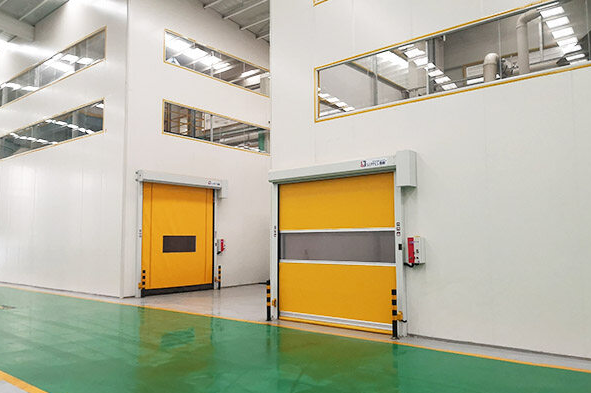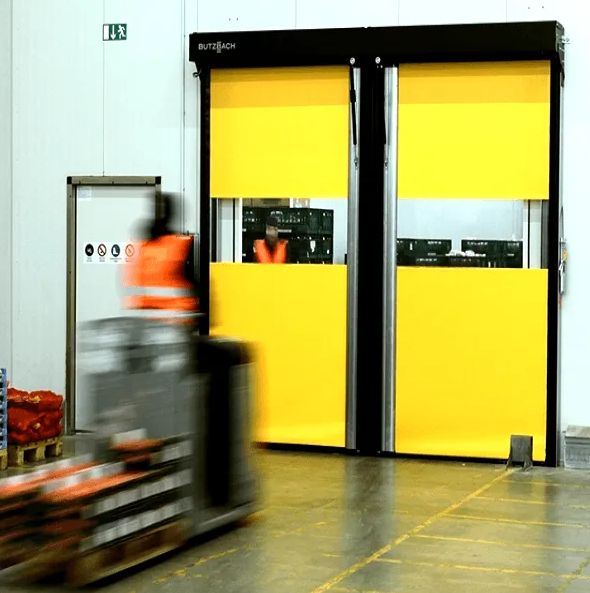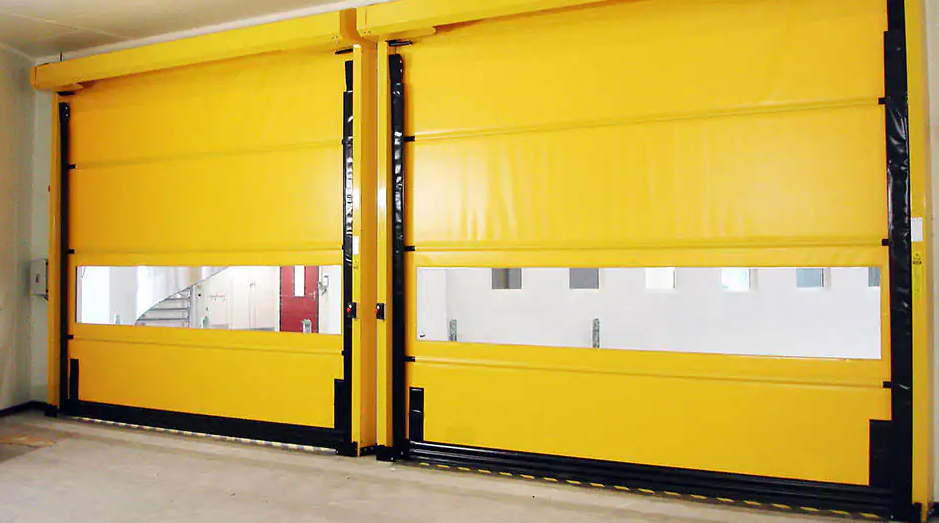High-speed doors are used for quick and efficient access in industrial settings, improving workflow, security, and energy efficiency.
Types of High-Speed Doors
High-speed doors come in a variety of styles and materials to meet the unique demands of different industries. Whether you’re looking to maintain temperature in a cold storage facility or secure high-value items in a warehouse, there’s likely a high-speed door designed for your specific needs. Below we delve into the different types of high-speed doors and their respective features.

Roll-Up Doors
Roll-up high-speed doors are incredibly popular in settings like warehouses, distribution centers, and factories. These doors roll up into a coil, helping to save valuable floor space. They are often made of durable materials like PVC and aluminum and are engineered for quick, efficient opening and closing cycles.
- Speed: These doors can open and close rapidly, reducing the time that the entrance is open and thereby saving energy.
- Space-Saving: The roll-up design takes minimal space, allowing for more room for equipment and operations.
- Durability: These doors are made to withstand harsh conditions, including high winds and drastic temperature changes.
Folding Doors
- Ease of Operation: These doors are incredibly easy to operate manually, though automated options are also available.
- Sealing: Excellent sealing capabilities make folding doors suitable for environments that require temperature or atmospheric control.
- Material Options: They come in various materials including wood, aluminum, and stainless steel.
Sliding Doors
Sliding high-speed doors are often used in high-traffic areas where speed is a necessity but roll-up doors are not practical. Hospitals, supermarkets, and certain manufacturing units often prefer sliding doors for their ease of use and installation.
- Horizontal Movement: These doors slide horizontally, making them ideal for areas where vertical space is limited.
- Automated Operation: These doors often come with automated controls for quick and hands-free operation.
- Safety Features: Built-in sensors for obstacle detection are common in sliding high-speed doors.
Other Specialized Types
Beyond the more common types of high-speed doors, there are specialized doors designed for unique applications. Examples include:
- Clean Room Doors: Ideal for pharmaceutical and food processing plants where contamination control is a major concern.
- Explosion-Proof Doors: Used in environments with hazardous materials.
- Cold Storage Doors: Specially designed for keeping temperature-sensitive goods, often seen in cold storage units and freezers.
Materials Used in High-Speed Doors
The material of a high-speed door plays a crucial role in its durability, maintenance requirements, and overall performance. Different materials offer various advantages in terms of strength, insulation, and cost. Here’s a closer look at some of the most common materials used in high-speed doors.
Aluminum
Aluminum is a popular choice for high-speed doors, especially in industrial settings. It is lightweight, rust-resistant, and relatively low-maintenance. Aluminum doors can be an excellent option for both interior and exterior use.
- Lightweight: Aluminum doors are easier to install and operate because of their lower weight.
- Corrosion Resistance: These doors are less likely to rust or corrode, making them ideal for harsh or humid environments.
- Aesthetic Appeal: Aluminum often provides a sleek, modern appearance, which can be an added benefit for businesses concerned about aesthetics.
PVC
PVC (Polyvinyl Chloride) is commonly used in roll-up high-speed doors. This material is highly flexible and can withstand repetitive cycles of opening and closing.
- Temperature Resistance: PVC offers good insulation properties, useful in temperature-sensitive environments like cold storage units.
- Cost-Effectiveness: Generally, PVC doors are less expensive than those made from other materials, making them a budget-friendly option.
Stainless Steel
For environments that require robust security or need to meet strict hygiene standards like in the pharmaceutical industry, stainless steel high-speed doors are often the go-to choice.
- Durability: Stainless steel is extremely durable and can withstand both physical impacts and corrosive elements.
- Hygiene: Easy to clean and resistant to chemicals, stainless steel is ideal for sanitary conditions.
- Security: The strength of stainless steel adds an extra layer of security, making it harder for unauthorized access.
Composite Materials
Composite materials are becoming increasingly popular in the manufacture of high-speed doors. These can include a combination of aluminum, PVC, and other elements, offering a blend of the best properties of each material.
- Versatility: Composites can be engineered to specific requirements, whether it’s enhanced durability or improved insulation.
- Weight Savings: These materials often weigh less than solid metal doors but offer similar or even superior strength.
- Environmental Benefits: Some composite materials can be more eco-friendly, aligning with sustainability goals.
Industries that Utilize High-Speed Doors
High-speed doors have become an integral part of various industries due to their speed, efficiency, and safety features. Let’s explore how different industries are leveraging the advantages of high-speed doors to meet their unique operational needs.

Warehousing and Logistics
High-speed doors find extensive use in warehousing and logistics for their rapid opening and closing capabilities. They help in maintaining organized traffic flow, thereby minimizing delays and ensuring smooth operations.
- Efficient Loading and Unloading: The speed of these doors helps in quick loading and unloading of goods, minimizing the time a truck stays idle at the dock.
- Temperature Control: High-speed doors can maintain different climate zones within a warehouse, crucial for storing temperature-sensitive goods.
- Security: With automatic locking features, these doors contribute to enhanced security, reducing the risk of theft or unauthorized access.
Food Processing Plants
Food processing plants have strict hygiene and temperature-control requirements, and high-speed doors can help maintain these standards.
- Hygiene: The easy-to-clean materials like stainless steel and PVC are often used for doors in food processing plants.
- Climate Zones: Different sections of a food processing plant may need different temperature and humidity levels, which high-speed doors can help maintain.
Pharmaceuticals
The pharmaceutical industry uses high-speed doors to maintain sterile environments, control air pressure, and ensure the highest levels of hygiene.
- Contamination Control: Specialized cleanroom high-speed doors can prevent cross-contamination.
- Compliance: These doors can help pharmaceutical companies comply with strict industry standards and regulations.
Automotive Industry
High-speed doors in the automotive industry contribute to an efficient and productive manufacturing environment.
- Assembly Lines: High-speed doors can separate different sections of the assembly line, allowing for an optimized workflow.
- Paint Booths: Special high-speed doors can isolate paint booths to prevent dust and contaminants from spoiling the paint job.
- Material Handling: These doors facilitate quick and efficient movement of materials and parts through the automotive production facility.
Key Benefits of Using High-Speed Doors
High-speed doors offer a plethora of advantages that can significantly improve the efficiency and security of an industrial or commercial setting. Here, we explore some key benefits of using high-speed doors across various sectors.

Speed and Efficiency
One of the most obvious benefits of using high-speed doors is their speed. The rapid opening and closing mechanisms can substantially reduce wait times, improving workflow and overall operational efficiency.
- Reduced Wait Times: The speed at which these doors operate minimizes time spent waiting for doors to open and close, crucial in high-traffic environments.
- Optimized Workflow: Faster operations enable smoother transitions between different areas, whether it’s moving from manufacturing to warehousing or from loading docks to storage areas.
- Operational Efficiency: Speedier doors mean less downtime, which can translate into higher productivity.
Energy Savings
High-speed doors contribute to energy efficiency by minimizing the amount of air that escapes from a controlled environment. This is particularly useful in temperature-sensitive areas.
- Climate Control: Quick opening and closing times limit the escape of conditioned air, helping to maintain a stable internal climate.
- Reduced Energy Costs: Less energy required for heating or cooling translates into financial savings over the long term.
- Environmental Impact: Energy-efficient operations align with sustainability goals, reducing the carbon footprint of the facility.
Security
The robust construction of high-speed doors, combined with advanced locking systems, offers enhanced security features.
- Limited Access: Automated high-speed doors can restrict access to authorized personnel only, minimizing the risk of unauthorized entry.
- Surveillance Integration: Many high-speed doors can integrate with security systems for added safety measures.
- Material Durability: Doors made from robust materials like stainless steel can withstand attempts at forced entry.
Hygiene and Contamination Control
High-speed doors can play a crucial role in maintaining hygiene, especially in sectors like food processing and pharmaceuticals.
- Easy to Clean: Materials like PVC and stainless steel are easy to sanitize, aiding in the maintenance of hygienic conditions.
- Sealing Capabilities: High-speed doors often come with excellent sealing properties, which prevent the ingress of dust, pests, and other contaminants.
- Regulatory Compliance: High-speed doors help in meeting industry-specific hygiene standards, such as those set by FDA for food and pharmaceuticals.
Safety Features
When considering high-speed doors, safety features are a priority. These doors often come with a range of safety mechanisms to prevent accidents and ensure smooth, secure operations. Let’s dive into some of the key safety features commonly found in high-speed doors.

Safety Sensors
Safety sensors play a vital role in accident prevention. These sensors detect any obstruction in the door’s path and stop or reverse the door’s motion accordingly.
- Motion Sensors: These sensors detect movement near the door and prevent it from closing if someone or something is in the way.
- Infrared Sensors: Utilizing infrared technology, these sensors identify heat signatures to stop the door from closing on a person or object.
- Sensor Integration: Many high-speed doors allow for the integration of safety sensors into existing security systems.
Emergency Release Systems
In case of power failure or malfunction, emergency release systems enable quick and manual operation of the door.
- Quick Release: Some high-speed doors come equipped with a quick-release feature for emergency situations that require rapid exit.
- Battery Backup: Some systems come with battery backup to allow for automated operation even during short-term power failures.
Visual and Auditory Warnings
To further enhance safety, many high-speed doors come with visual and auditory warning systems.
- Warning Lights: Flashing lights alert individuals in the vicinity that the door is about to open or close.
- Auditory Alarms: A beeping or buzzing sound serves as an additional warning that the door is in operation.
- Signage: Clear signage, often required by safety regulations, informs people about how to operate the door safely or avoid the door area during operation.
